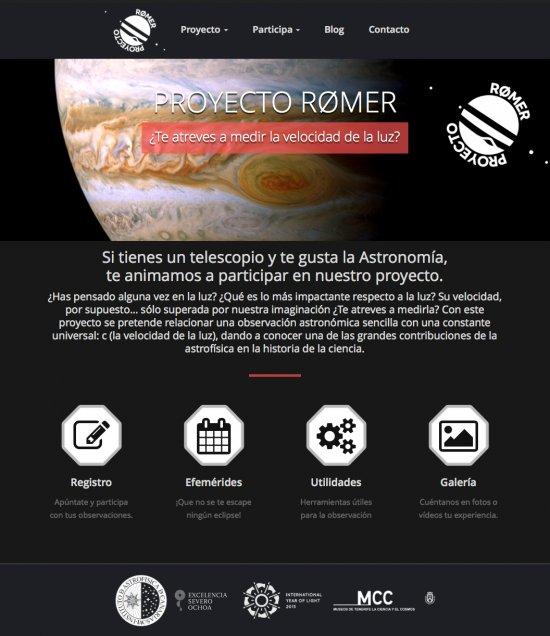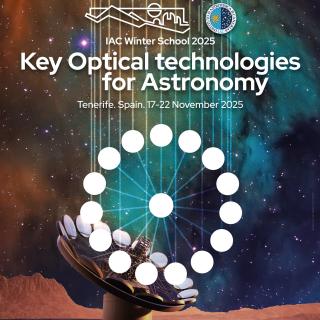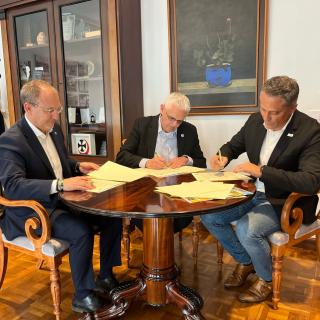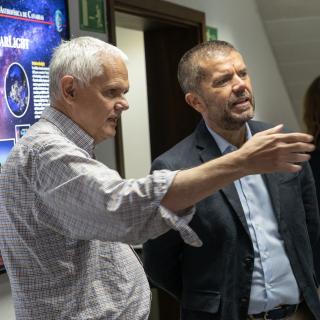The United Nations Organization (UNO), at the 68th meeting of its General Assembly, dubbed 2015 as the International Year of Light, as during this year we will be celebrating the anniversaries of a number of discoveries in the field during the past thousand years, such as the studies in optics of Ibn Al-Haytham in 1015, the theoretical description of the photoelectric effect by Albert Einstein in 1905, or the incorporation of light into cosmology in 1915. Light is the basic tool of astrophysics. Light hast told us by far the major part of what we know about the universe. And if there is something particularly surprising about light, it is its velocity, not surpassed by any known physical phenomenon. This is why the Institute of Astrophysics of the Canaries (IAC) and the Museum of Science and the Cosmos (MCC) has set in operation the “Römer Project” in which participants who want to do so are invited to collaborate in the measurement of this universal constant, which is represented in physics by the letter “c”.
The aim of this project is to popularize astrophysics and fundamental physics, by showing how a relatively simple astronomical observation can be used to measure the velocity of light. Anybody can participate by making observations from telescopes which can be quite small, and need not be professional. This method was invented by the Danish astronomer Ole Römer in 1676, and using it he measured the velocity of light for first
“The method” explains Alfred Rosenberg, and astrophysicist and the director of the project on behalf of the IAC “is really simple. It entails measuring the apparent change in the period of rotation of Io, one of the satellites of Jupiter, depending on our distance from it. The satellite behaves as the hand of a clock, orbiting Jupiter roughly every 42.5 hour. An observer on Earth can see when Io´s orbit takes it into the shadow of Jupiter; it then disappears, and reappears later.
But the Earth is moving on its orbit round this sun so that we see these disappearances (“occultations”) and reappearances from different distances; the maximum difference is roughly the diameter of the Earth´s orbit, 2 Astronomical Units, or some 300,000km). So, as we know the velocity of light, we can predict that there will be a difference of about 1,000 seconds (the time taken for light to travel across a diameter of the Earth´s orbit round the Sun) between the moment of the observation of the occultation when we are at our nearest point to Jupiter (termed conjunction) and the moment of the observation when we are at our farthest point from Jupiter (termed opposition). If we take measurements of the times of occultation and reappearances of Io during six months, or more, and plot them on a graph we will find a steady increase and decrease in the time of occultation. Measuring the difference between the maximum and minimum of these times should give a value of around 1000 seconds. From our measured value, and knowing the distance of the Earth from the Sun we can recalculate the velocity of light.
People who want to participate should first register giving certain data of interest, (a codename, the diameter of their telescope, the magnification of the eyepiece etc.), and afterwards, using another form, the exact time (using GPS if possible) at which they observed the reappearance of Io .The best time to start the project would be from February 6th, (when Jupiter is at conjunction) and to keep observing for some six and a half months, although one could keep on observing for the remainder of the year. “The problem could be” warns Oswaldo González, the astrophysicist in charge of Didactics at the Museum of Science and the Cosmos, “that Jupiter can be observed from the early part of the night for these first six months, and then only in the early hours of the morning”.
There is a website for the project, with results, interesting links, instructions on how to observe, when the next reappearances of Io are due. Participants may send, as well as their measurements of the times of reappearance, photos, videos, and so on, which will be incorporated into a gallery of results. We will produce a blog dedicated to the project
“The project is not so much about really measuring the velocity of light” says Alfred Rosenberg “ but to give people the chance to feel the excitement of observing and participating in a project which, 339 years ago, le Ole Römer to measure a value which nobody had dreamed of previously”
According to Oswaldo González “Project Römer is designed to be international, in the sense that anybody can join in, from wherever on Earth he or she is situated. All it need is to be able to observe the transits from anywhere. So all contributions are warmly welcome”
For more information:
Museums of Tenerife: 922-209318 (Oswaldo González, Museum of Science and the Cosmos)
Unit of Scientific Communication and Culture: 660-574-116 (Alfred Rosenberg, IAC)
Web site of the project: http://www.iac.es/romer



